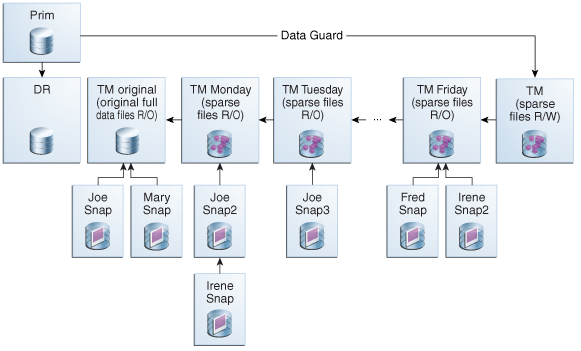9.7.7.4 Task 4: Create a New Sparse Test Master Using a Previously Created Sparse Test Master
Create a new set of snapshots to provide a new test master and new sparse files to contain changes from the primary.
It is possible that at periodic intervals you will want to use the standby database to create additional snapshots without having to build a complete copy of the test master. You can repeat the process performed in the previous three tasks to do just that, taking advantage of the hierarchical snapshot functionality. The new test master is built on top of the latest existing snapshot that is applying redo. This snapshot becomes read-only and a new snapshot is built to continue the redo apply processing.
Do the following to configure the standby for the new test master time line:
Figure 9-17 Configuration After Repeating the Process

Description of "Figure 9-17 Configuration After Repeating the Process"
The process to create a new sparse test master can be repeated up to 9 times, which would create an environment 10 levels deep with the original standby data files and 9 hierarchical snapshots. When repeating the process for the ninth time, do not create a new snapshot to receive the redo from the primary database.
Figure 9-18 Potential Future Configuration

Description of "Figure 9-18 Potential Future Configuration"
If you reach the maximum 10 levels, you have multiple options:
-
If you have enough space to maintain multiple copies of the standby database and snapshots, then create a new tree of hierarchical snapshots based on another standby database. The original standby data files and snapshots can remain as long as required.
-
If you do not have enough space to maintain multiple copies of the standby database and snapshots, then:
-
Delete the snapshots and their associated data files, including any snapshots used as test masters.
-
Refresh the standby.
-
Create a new tree of hierarchical snapshots.
-
-
Create a new standby database on a different environment and create a new tree of hierarchical snapshots.